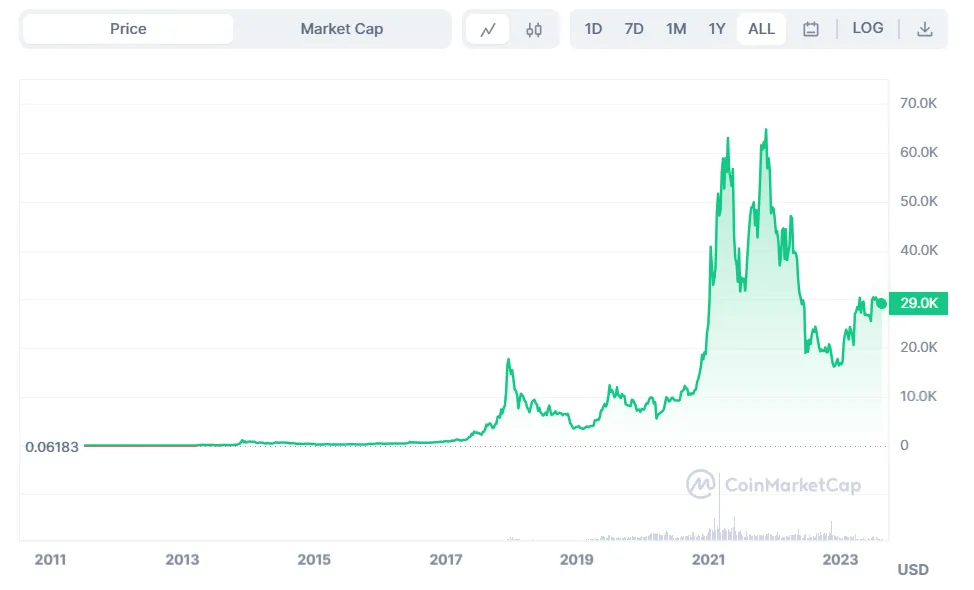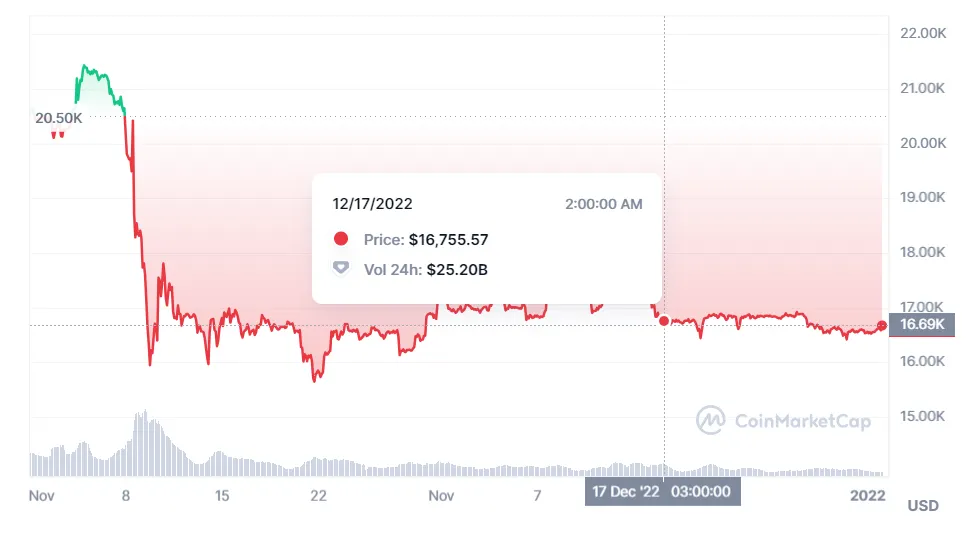Why Do You Want To Invest in Crypto?
There are numerous stories within the crypto news ecosystem of people getting huge returns. In some cases, they invested very early into projects like Bitcoin, Ethereum, and a host of others; they then patiently held their crypto (or kept buying and accumulating more) for years and then sold some — or all it — later for huge returns. In other instances, they purchased a small-cap memecoin and ended up getting huge returns after a much shorter time frame — sometimes after only holding their investment for a few weeks or days. On the flip side of the block, there are also stories of people incurring huge financial losses. These often receive less news coverage.
In any case, the hope — or promise — of healthy returns is one reason that the blockchain space has attracted a sizable group of nascent crypto investors. Of course, there are other motivations for being financially intertwined with the crypto scene. You may be fascinated with the tech of peer-to-peer (P2P) cryptocurrency, crypto wallets, and decentralized finance (DeFi). You could also think crypto is a huge net good for the world that will allow those in both the developed and developing world to flourish and achieve their utmost potential. In the author’s case, it’s all three.
For nearly all crypto investors, the desire to see profitable returns — or at least preserve the purchasing power of your existing savings — is a major motivator for getting involved in blockchain-based investing opportunities. Let’s be honest, many just invest with the hope or wish that the price goes up.
While some blindly invest, others may want to dive right into the nuances of chart patterns, technical analysis, fundamental analysis, and a host of other tools and strategies that may give them an investing edge. While all of this can be useful, you should start with knowing what not to do. While all investors make mistakes, making life-altering mistakes can be avoided (or minimized) if you follow some general guidelines and rules. We’re going to assume that getting investment returns is at least part of your motivation.
Please note: The following subject headers describe what not to do. They are not to be taken as advice; you should probably do the opposite.
Learn the Art of FOMOing
An acronym that means “fear of missing out” (FOMO), FOMO in investing is a common mistake for new investors. This typically means buying crypto after it has risen parabolically upwards with the belief — often mistaken — that the project will continue to rise after you have made your investment. Oftentimes, these investors continue to wait before investing to make sure the project continues to appreciate in value. Then, they end up buying at or near the new all-time high (ATH) price of that asset.
In December 2017, bitcoin (BTC) hit a new ATH of $20,000. At that moment, many people who had never bought BTC bought some for the first time — ostensibly hoping that the skyward price movement would continue. As you can see below, that didn’t happen. As the price trended downward, many of these investors started to worry — or panic.

Some sold as soon as the price dipped below $20,000, while others may have held out until $18,000 or $15,000 until cutting their losses. Others managed to hold out for longer but ended up selling for an even greater loss. As the chart shows, the price dropped to nearly $3,000 per BTC — equating to a net loss of around $17,000 if you bought near the top and sold near the bottom. For many without a long-term plan, they sold some or all of their BTC due to the emotional pain of seeing the price go down. Others bet more than they could afford to lose and had no choice but to sell for a loss — a painful lesson in risk management.
Try not to FOMO invest. When skyward price increases seem too good to be true, they often tend to correct sharply in the opposite direction shortly afterwards.

Have No Plan Whatsoever
When others ended up selling for a steep loss, others were able to ride out this bear market and do well. Why? They actually had a plan. For example, a basic buy-only BTC plan could have looked something like this (using our buying BTC in Dec. 2017 example):
- Only buy as much BTC as you can afford to lose.
- Hold this BTC for a minimum of 4 years before selling.
In this case, a four-year wait would allow you to sell for around $50,000/BTC, more than doubling your money — despite FOMOing in during an earlier BTC price spike. As you didn’t invest more than you were willing to lose, you were able to ride out the volatility and the substantial price drop prior to the recovery and the setting of new ATHs. Of course, you could keep the same plan as above but add in some additional rules:
- If BTC triples in price within 4 years, you must/can sell ⅓ of your BTC investment.
- If BTC hits $100,000, sell another ⅓ of your investment.
- Hold the remaining ⅓ for ten years (or until $500,000/BTC).

Of course, this advice is easy to give in hindsight. However, having any sort of basic investing plan can help steer you in the right direction. For example, you could plan to hold BTC for a minimum of 5 years — instead of 4 like in our aforementioned example. In this case, you would still be down $2,000-4,000/BTC as seen here:
However, this would still be preferable to selling at a much lower price point (like $5,000) had you sold without a plan for much less (as many ended up doing). Beyond this, you may have ultimately decided to alter your plan and continue holding your investment to this day, leaving you with a net gain of approximately $9,000/BTC ($29,000-20,000, at time of writing). Maybe you’ve decided to wait another five years before selling in the hope that it will continue to gain in value over time.
Or, you may have strategically broken your plan in a way that you were happy with. For example, you may have ultimately decided to sell some — or all — of your BTC when it hit $60,000+ prior to your five-year wait.
Have a crypto investing plan — and try to stick with it — while remaining flexible.
When Investing, Listen to Your Heart
I’m kidding, you should have at least a partially brain-led plan. In fact, emotional investing is what you don’t want to do. You may want your crypto investment to stratospherically rise in value in a short period of time, but that doesn’t mean that it will. When investors listen to their instincts and emotions, they tend to make more, and bigger, mistakes. For this reason, like shopping, you may want to avoid making impulse buys — and impulse sells.
Your best bet is to have a plan when you invest. Questions you should ask yourself include:
- How much do you want to invest?
- Can you afford to lose money on this investment? If so, how much?
- How long do you plan to hold the investment?
- At what price point will you profitably sell (25/50/75/100%) of specific tokens?
- Do you want to hold for long-term capital gains upsides?
- Do you plan to rebalance your crypto portfolio periodically?
- At what price point, if any, will you sell for a loss?
- Do you plan to buy via periodic dollar cost averaging? Or make a large one-time buy?
While you don’t necessarily need to have answers to every question listed above, you should at least have a few of them answered before actually making any significant investments (based on your personal financial situation). While not every investing what-not-to-do is related to emotional (and sometimes irrational) decisions, avoiding many of these upcoming pitfalls has a lot to do with listening to the logical and rational part of your brain. Investing hopium will not get you far.
Don’t succumb to emotional investing. Stick to your plan and avoid the potential pitfalls of emotion-driven investing decisions.
Don’t Learn From the Mistakes of Others
Of course, FOMO buying is an investing tale as old as time — and is also quite common in the stock trading world as well. It is likely that some repeated the same FOMO mistakes during the two subsequent surges that saw BTC fly past $60,000 and then drop by more than $20,000 nearly as quickly as it rose. Let’s say that you bought $60,000+ BTC with the hopes that it would continue to soar. Yet, like the previous surge to $20,000, it also receded sharply.
If you haven’t already sold for a loss, it may be because you have a similar plan to the one mentioned above that includes the need to hold this investment for a minimum of 4–5 years. That would entail holding this investment until 2025 or 2026. If you believe in the long-term price appreciation of BTC, this could still end up being a (very) profitable — but long-term — investment. Even though you bought at or near the ATH, you have a chance to sell for a healthy profit by taking a wait-and-see approach.
If you think it is likely that BTC will surpass $100,000 by the mid-2020s, you can start coming up with your personal investing plan now. Maybe you want to sell a percentage at this price point ($100,000) while holding the remainder in the belief that the price will continue to increase into 2030 and beyond. While buying at a peak is not ideal, you can compound this mistake by selling too quickly — often called panic selling. However, there is no guarantee that BTC or other cryptos will continue to appreciate in price.
Learn from the mistakes of others. Doing some basic research and consuming some investing content can help you learn from others’ mistakes — so you don’t have to repeat these same mistakes yourself.
Crypto Investing Mistakes To Avoid
Investing mistakes include FOMOing into crypto projects, emotional investing, not having a plan, and not learning from others’ (or your) past mistakes. However, this isn’t a comprehensive list. Other mistakes to avoid include panic selling, not doing your own research (DYOR), the sunken cost fallacy, crypto maximalism, lack of risk management, and emotional investing mistakes that pertain to being too greedy — or too fearful. In the next article, we’ll cover more of the things you should strive to avoid when investing in crypto.
Disclaimer: This investing series is strictly for informational and entertainment purposes. It should not be construed as financial or investment advice. Do not invest based on price prediction tools or forecasts laid out in this series. Please consult an investing professional or financial planner if you feel you need investment guidance.
Cheat Sheet
- Know the reason(s) you’re investing in crypto.
- FOMO investing involves buying quickly appreciating assets that may be overvalued and may drop sharply in value. This should be avoided.
- Having an investing plan can prevent you from making impulsive and emotional investing and trading decisions that you end up regretting — and that hurt your portfolio’s performance.
- Consuming investing content can help you learn from the mistakes of others so you reduce your investing blunders.
- Learning how not to invest may be even more important than learning advanced trading and investing techniques.


